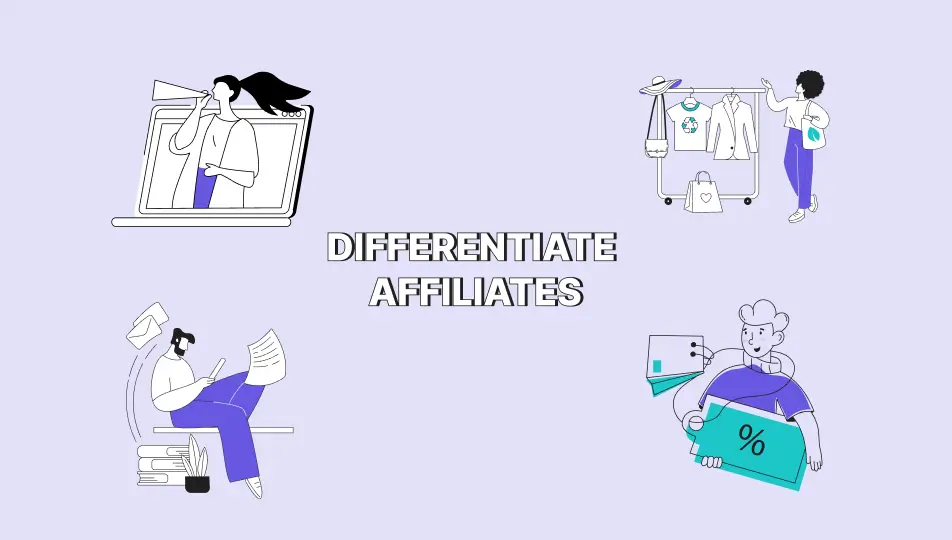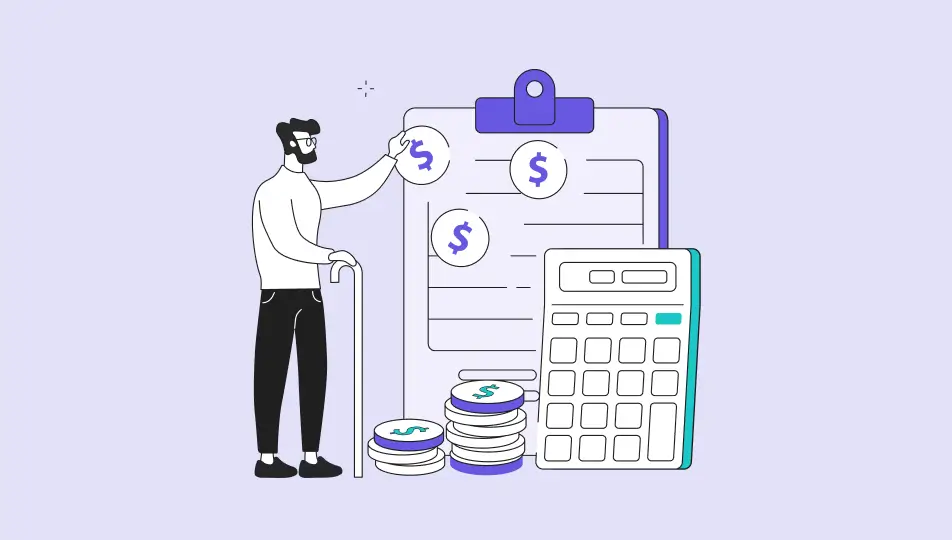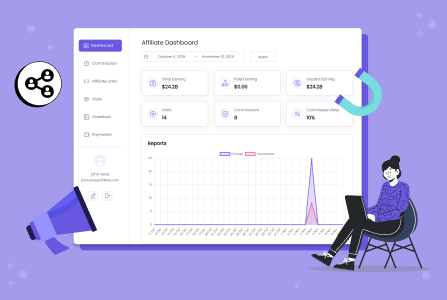A Complete Guide to Setting Affiliate Commission Rates (2025)

- Step 1. Calculate Your Profit Margins
- Step 2. Make Competitor Research to Understand the Standards
- Step 3. Consider Your Product/Service Type
- Step 4. Evaluate Your Marketing Goals
- Step 5. Differentiate Affiliates by Their Type
- Step 6. Consider These Extra Factors
- Step 7. Reflect Your Commission Rates Dynamics in Your Policies
- Step 8. Simplify Workflow with Affiliate Software
- What Are Final Takeaways on Affiliate Commission Rates Setting?
Are you an entrepreneur or a business owner considering starting an affiliate program or looking to optimize your existing one? The truth is: growing without affiliates and partners is getting harder and harder. No matter what type of products or services you sell, it’s crucial to start with understanding the actual impact of commission rates on your profitability and affiliate recruitment.
But sometimes you just need to repeat and understand the basics to start the right way or see what you might be doing wrong. That’s our task for today!
We’ll be looking into how affiliate commission rates are determined, how to negotiate better deals with merchants, and what the best ways to customize commissions based on different partners are.
To start, let’s highlight the key points you should keep in mind to customize affiliate commission:
- business goals.
- industry standards.
- profitability.
And now, let’s do some math.
Step 1. Calculate Your Profit Margins
In simple language, profit margin is all about finding a sweet spot for your affiliate commissions. You need to pay enough to attract good affiliates, but not so much that you’re losing money on each sale.

It’s easier to understand it with an example:
- High-margin products (jewelry, luxury items, software) normally afford higher commissions (20-50% or more). For example, if you sell WordPress plugins, which are considered digital products, you are expected to pay a commission of up to 50%. Subscriptions often offer 15-30%, with recurring commissions for subscriptions.
- Low-margin products (groceries, books) require lower commissions (1-10%).
Needless to say, you may customize the selection of products that take part in the affiliate system. Only choose products that make you enough money to share some of the profits with affiliates. Moreover, keep in mind the brand’s popularity of the products you are selling. For example, high-end make-up brands can command premium prices, and then profit margins increase. Amazon also has a margin on certain categories.
Step 2. Make Competitor Research to Understand the Standards
As a merchant/advertiser, you can’t play alone because you are targeting the same audience as your competitors. The more competitive the market is, the more pressure on prices and affiliate commissions.
That’s why you can skip the step of researching the standard commission rates to determine affiliate commission rates that would work for your products or services.
Of course, you can downplay or create your own rules but always remember that that may scare away your affiliate chances. So, grab your Excel document and start creating a competitor table with their affiliate commission rates highlighted, including their rules and policies.
Step 3. Consider Your Product/Service Type
Don’t neglect the fact that commission rates for affiliate programs should vary depending on the product or service type.

One-time purchases often require higher commissions to attract new affiliates, but subscription-based services usually allow for lower rates due to the potential for recurring income for affiliates.
You may also offer commission rates only on the first sale or the first year of subscription.
Step 4. Evaluate Your Marketing Goals
Think of your starting point when opening an affiliate program. If you’re introducing a brand-new product or trying to break into a market with high competition (where everyone else is already doing well), you might want to offer more generous commissions at first, and then slowly change your policies or increase requirements.
This will help you attract top-notch affiliates who can really get the word out and help your product gain some serious attention.
Step 5. Differentiate Affiliates by Their Type
Get to know your affiliates and try to negotiate the best deals with the best content creators, don’t wait for bloggers, influencers, and website owners to register by themselves and promote your products. Offer them the commission rates that suit their reach and audience!

The big players in the affiliate game, like famous influencers and popular websites, will likely want higher commissions because they have a huge audience and can bring in tons of traffic.
Broadly, we can categorize those into:
- Influencers, big publishers (so-called top-tier affiliates). They may demand – or you can offer them – higher commissions that can potentially generate a lot of traffic.
- Smaller affiliates (bloggers, niche websites). Such affiliates might be happy with lower rates because they can reach a very specific group of people who are really interested in your product.
Get flexible!
Step 6. Consider These Extra Factors
There are a few marketing terms that are also critical for setting up your affiliate commission rates. They will help you balance the rates between the industry standards and the realities of your actual business performance.

- Customer Lifetime Value (CLV) – understand the long-term value of your customer; if a new customer is likely to make repeat purchases, you can afford a higher upfront commission.
- Conversion rates – if your product is sold pretty well, affiliates might accept lower commissions because they might not need to lift a finger and do constant updates. If not, then higher commissions may play a role in attracting affiliates.
- Affiliate network fees – if you’re using a third-party affiliate network to offer your affiliates your services, consider their fees when determining commission rates.
Step 7. Reflect Your Commission Rates Dynamics in Your Policies

A dedicated affiliate program’s policy page will help you customize your rates even further and make payouts only when certain conditions are met.
- Acceptance limits and affiliate rejection rules.
- Specify percentages, excluded products, and how commissions are allocated.
- Terms and conditions, refund policy, and additional rules.
- Clear cookie policies.
- A statement that you reserve the right to change this policy at any time.
Step 8. Simplify Workflow with Affiliate Software
Luckily, many affiliate management software providers have already implemented multiple features based on the industry’s needs and insights. It won’t just optimize sales tracking, but will also help you customize commissions, discounts, and other marketing activities related to setting up affiliate commissions.

This means you can manage all the affiliate program details, including commissions, based on the ecosystem that is already customized for any scenario.
For example, affiliate software, among other things, can help you:
- Adjust commissions for refunds.
- Simply affiliate onboarding.
- Set up sign-up forms and spam protection.
- Set up automatic or manual approval.
- Group affiliates using tags.
- Share creative assets for affiliates.
- Use coupons for discounts.
Needless to say, they will deal with the cookies, referrals, and the entire network management.
What Are Final Takeaways on Affiliate Commission Rates Setting?
Managing affiliate commissions as a merchant has a direct influence on your ROI (return on investment), meaning the profit generated from affiliate campaigns compared to the amount spent.
- Start with your profit margin to make sure you’re still making enough profit after you pay your affiliates.
- If your profit margin is very tight, it might be hard to pay affiliates enough money to keep them happy.
- Accept the fact that you might need to talk to affiliates and customize your rates based on their popularity, efforts, and reach.
- Create your own affiliate program with the software.
- Craft the affiliates’ policies page.
Finally, don’t wait until you have to use affiliate marketing to survive as a business. Start using it now to get ahead and grow.




